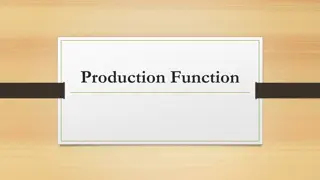Cost-Benefit Analysis of Spices Production in Peren District, Nagaland
Horticulture in Nagaland presents a lucrative opportunity, with the cultivation of 24 spices including Cardamom, Ginger, Turmeric, and Naga King Chilly. This study in Peren District examines the production trends and cost-benefit analyses of Naga King Chilly, Turmeric, and Ginger. Research methodology involved primary and secondary data sources, with personal interviews of 150 sample respondents in six villages. Results and discussions include the distribution of age groups, farm sizes, educational qualifications of farmers, and the production and returns of spices.
Uploaded on Sep 07, 2024 | 3 Views
Download Presentation

Please find below an Image/Link to download the presentation.
The content on the website is provided AS IS for your information and personal use only. It may not be sold, licensed, or shared on other websites without obtaining consent from the author.If you encounter any issues during the download, it is possible that the publisher has removed the file from their server.
You are allowed to download the files provided on this website for personal or commercial use, subject to the condition that they are used lawfully. All files are the property of their respective owners.
The content on the website is provided AS IS for your information and personal use only. It may not be sold, licensed, or shared on other websites without obtaining consent from the author.
E N D
Presentation Transcript
COST BENEFIT ANALYSIS OF THE PRODUCTION OF SPICES IN PEREN DISTRICT, NAGALAND S TEMSUSENLA AO & DR. DEBOJIT KONWAR RESEARCH SCHOLAR & ASSOCIATE PROFESSOR ST. JOSEPH UNIVERSITY, CH MOUKEDIMA, NAGALAND, INDIA
INTRODUCTION Horticulture known to be the cash crop. The Nagaland State horticulture crops are emerging as a potential enterprise. Nagaland is registered as the 16th State of the Indian Union. Nagaland has very good agro-climatic conditions. India grows 75 types of verities of spices out of 109 varieties which are listed according to the International Organization for the Standardization (ISO). Nagaland cultivates 24 spices in total out of which the major spices cultivate in the State are Cardamom, Ginger, Turmeric, and Naga king chilly. The selected species for present topics were Ginger Turmeric Naga King Chilly
OBJECTIVE The objectives are as follows 1. To analyze the production trend of the spices specifically Naga King Chilly, Turmeric, and Ginger in Peren District. 2. To analyze the cost benefit analyses of the spice s cultivators specifically Naga King Chilly, Turmeric, and Ginger in Peren District. HYPOTHESIS 1. H0: There is no significant relationship between age of the farmers and income generation.
RESEARCH METHODOLOGY The study was carried out based on primary data and supportive of secondary data sources. Simple random sampling technique was applied. Sample size of 150 under Peren District which consists of six villages i.e., Tesen Village, Peletkei Village, Dunglwa Village, Peren Village, Tening Village, and Pulwa Village. Personal interview was carried out along with the help of a structured questionnaire. Krejcie Morgan method was used for analyzing sample size population
Figure 1 Age Group Distribution of the sample Respondents Figure 3 Farm Size of the Farmers 40 35 30 25 20 15 10 5 0 20-25 25-30 30-35 35-40 40-45 45-50 50-55 55-60 60 above Marginal Farmer Small Farmer Semi-Medium Farmer Medium Farmer Male Female
Figure 2 Educational Qualification of the farmers 70 60 50 40 Peren 30 20 10 0 Illiterate Lower Primary School HSLC HSSLC Graduate
Figure 4 Production of Spices Figure 5 Returns of Spices 120000 10000000 9000000 100000 8000000 7000000 80000 6000000 5000000 60000 4000000 40000 3000000 2000000 20000 1000000 0 0 Marginal Farmer Small Farmer Semi-Medium Farmer Medium Farmer Marginal Farmer Small Farmer Semi-Medium Farmer Medium Farmer Naga King Chilly Turmeric Ginger Naga King Chilly Turmeric Ginger
Table 1 Cost Estimation Per Hectare of Naga King Chilly, Turmeric Table 2 Cost and returns of Naga King Chilly, Turmeric and Ginger and Ginger Farm Size King Turmeric Ginger Total Spices Cost Return Net Return BCR Chilly Marginal Famer (Below -- 17218.22 16950 34168.2 Naga King Chilly 55543.53 96935.08 41391.55 1.75 1 Ha) Small Farmer (1-2 ha) 23371.5 10046.09 11845.24 45262.9 Turmeric 2 27264.31 32404.51 5140.20 1.19 Semi-Medium Farmer 14963.8 -- -- 14963.8 (2-4 ha) 4 Ginger 28795.24 41611.9 12816.66 1.45 Medium Farmer(4-10ha) 17208.1 -- -- 17208.2 7 Total 111603 170951 59348.4 4.39 Total 55543.5 27264.3 28795.2 111603 Source: Primary data collected from field work Source: Primary data collected from field work
Table 3 Income Generation of Naga King Chilly, Turmeric and Ginger Spices Production Income Income Per hectare Naga King Chilly 199780 33463150 96935.08 Turmeric 36794 3104677.72 32404.51 Ginger 7020 618672.60 41611.90 Total 243594 37186500 170951.5 Source: Primary data collected from field work
Table 6.1 (I): Model Summary of Peren Districts Model R R Square Adjusted R Square Std. Error of the Estimate 1 a. Table 6.1 (II): ANOVAb Peren Districts Model .843a .710 .700 .57521 Predictors: (Constant), Age, Land, Education, Labour, Seed Sum of Squares df Mean F Sig. Square Regression 116.549 47.645 164.193 5 144 149 23.310 .331 70.451 .000a Residual Total a. Predictors: (Constant), Age, Land, Education, Labour, Seed. b. Dependent Variable: Income Table 6.1 (III): Coefficientsof Chomoukedima Districts Model Unstandardized Coefficients Standardized Coefficients t Sig. B .227 .068 .755 .093 Std.Error .126 .030 .073 .049 Beta (Constant) 1.809 2.281 10.386 1.883 .073 .024 .000 .062 .106 .832 .121 Education Land Seed
CONCLUSION The study has shown a positive impact of cost benefit for the cultivation of the spices of major spice like Naga King Chilly, Turmeric and Ginger. The production of cash crop spices has greater benefits to generate income with less cost management. Look into infrastructure. Training Facilities. Knowledge on financial assistance.























